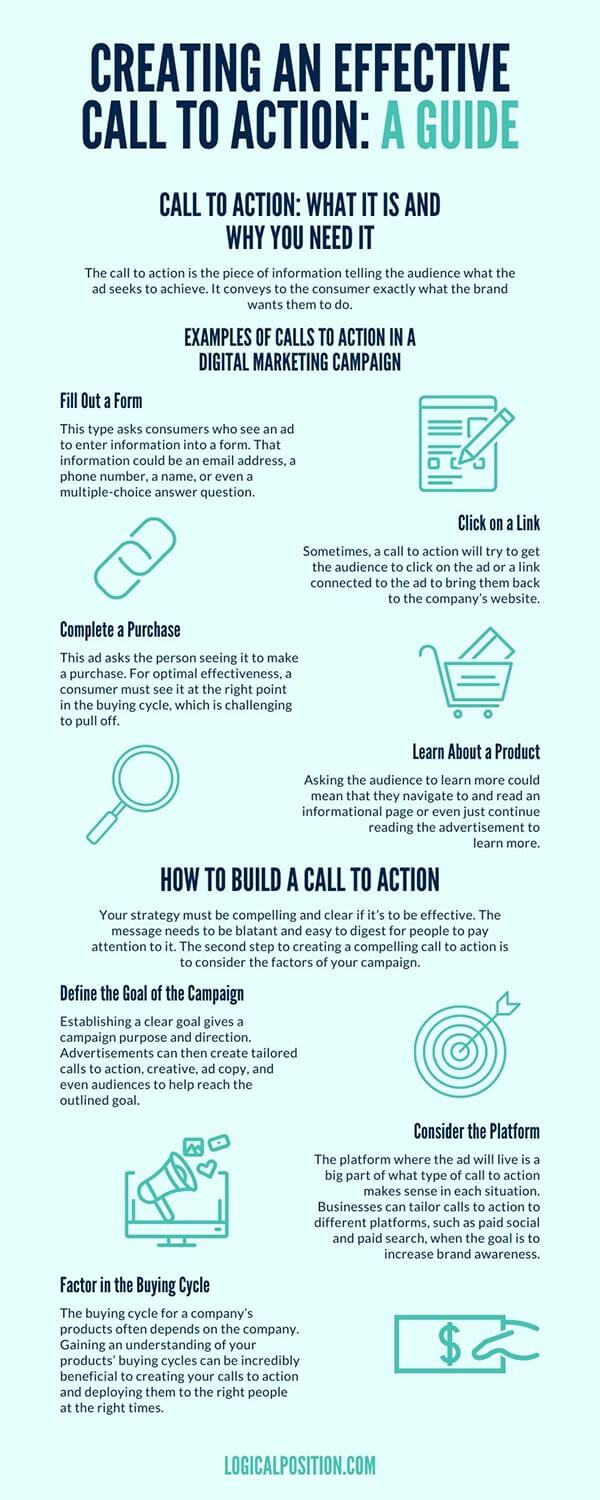There’s an old saying that companies need to spend money to make money, and in the current digital age, this couldn’t be further from the truth. Many industries are experiencing saturated markets because of the ease of access from wider audiences than ever before. With the fierce competition that exists now and continues to grow, businesses are beginning to recognize the importance of investing in digital marketing.
Digital marketing is the future of how consumers find companies. The immense competition online makes marketing imperative for businesses that want to see success and continue to grow. Digital marketing is successful for many companies—but only when they embrace careful strategy, expertise, and a clear, concise call to action.
An advertisement may contain all the essential elements, such as creative copy and compelling narrative. Still, without a clear and straightforward call to action, audiences won’t know what to do with it. Explore the steps to creating a compelling call to action: a guide to digital marketing for businesses.
Call to Action: What it is and Why You Need it.
A call to action is something that every successful advertisement needs to work. The call to action is the piece of information telling the audience what the ad seeks to achieve. It conveys to the consumer exactly what the brand wants them to do.
There are various types of calls to action, and many brands utilize different techniques to reach their unique goals. When creating a compelling call to action for specific advertisement types, there is much to consider, and ads using the wrong kind of strategy often fail to yield desired results. The first step to creating a compelling call to action is to understand what it is and why it’s so vital.
Examples of Calls To Action in a Digital Marketing Campaign
There is more than one type of call to action. Most of the time, the strategy a company chooses depends on the campaign’s overall goal. One way to think about a call to action is to ask: “What do I want the person who sees this ad to do?” The answer to this question informs your call to action. Below are some standard techniques.
Fill Out a Form
One of the most common calls to action is to “fill out this form.” This type asks consumers who see an ad to enter information into a form. That information could be an email address, a phone number, a name, or even a multiple-choice answer question.
Click on a Link
Sometimes, a call to action will try to get the audience to click on the ad or a link connected to the ad to bring them back to the company’s website. “Click here” or “visit our website” are common ways to phrase this call to action.
Complete a Purchase
A challenging yet not uncommon call to action to navigate is the “make a purchase” one. This ad asks the person seeing it to make a purchase. For optimal effectiveness, a consumer must see it at the right point in the buying cycle, which is challenging to pull off.
Learn About a Product
Another commonplace call to action asks the viewer to learn more about a product or brand. Asking the audience to learn more could mean that they navigate to and read an informational page or even just continue reading the advertisement to learn more.
Why a Call To Action Is Necessary
A single, clear, and concise call to action is necessary for a successful advertisement, regardless of the platform or ad type. A call to action tells consumers exactly what to do when they see an ad. Without this vital piece of information, ads are often ineffective or, worse, confuse potential customers. A call to action ensures that the audience can easily digest your ad and follow its goal. Effective advertisements help a business achieve its goals, and a call to action guarantees the active pursuance of those goals.
How To Build a Call To Action
Once you have a basic understanding of calls to action, building one is the next step. Merely having a call to action isn’t enough. Your strategy must be compelling and clear if it’s to be effective. Consumers are often not willing to work to figure out what an ad wants them to do. The message needs to be blatant and easy to digest for people to pay attention to it. The second step to creating a compelling call to action is to consider the factors of your campaign.
Define the Goal of the Campaign
Every business that invests in digital marketing must define what they wish the campaign’s results to be. Establishing a clear goal gives a campaign purpose and direction. Advertisements can then create tailored calls to action, creative, ad copy, and even audiences to help reach the outlined goal.
Consider the Platform
The platform where the ad will live is a big part of what type of call to action makes sense in each situation. For example, if your campaign goal is to entice a person who already visited your site and put something in their cart but didn’t check out to complete the purchase, pay per click advertising may not be the most direct line to that person. In this scenario, the best platform to use might be email marketing or social media remarketing.
Businesses can tailor calls to action to different platforms, such as paid social and paid search, when the goal is to increase brand awareness.
Factor in the Buying Cycle
The buying cycle for a company’s products often depends on the company. For example, a company that sells inexpensive shoes may make many sales on impulse purchases, but a business that sells software most likely never gets conversions on impulse. This gap in impulse purchase conversions is because the buying cycle for products such as software can include six months to a year of research before a person or entity purchases the product.
Gaining an understanding of your products’ buying cycles can be incredibly beneficial to creating your calls to action and deploying them to the right people at the right times.
Pro Tip: Even the most compelling calls to action won’t be effective when they reach a person at the incorrect point in the buying cycle.

How a Professional Digital Marketing Agency Can Help
While many companies attempt to run their digital marketing campaigns themselves using in-house creatives and personal experience, they often find the time commitment strenuous and the lack of expertise detrimental to their success. To unleash a company’s full potential through paid advertising takes years of experience and lots of careful time and research to determine how to reach the right people at the right time through the right channel to yield results.
Hiring a professional digital marketing agency means that business owners can focus on running the business and preparing for the influx of conversions brought on by their conversion-driven campaigns managed by dedicated professionals.
Everything matters
As mentioned above, even the most compelling calls to action don’t always yield the results you want. Much more goes into advertising to make it successful. Ads must have a captivating creative, persuasive call to action, creative ad copy, and reach the correct audience at the right time in their buying cycle to deliver real results. These factors create too many moving parts for a dynamic company to juggle while it’s busy running its own business.
Proper Calls To Action Take Time and Expertise
Curating a call to action that gets results and works toward a central campaign goal is not an easy task—especially for a busy business owner. Digital marketing agencies employ experts and assemble a team to tailor each ad to achieve the outlined goals.
Effective Digital Marketing Pays Off
Digital marketing, when done correctly, can produce an excellent return on investment—or return on ad spend! Often, companies that attempt their own digital marketing find it challenging to create advertisements that garner results. It’s not uncommon and indicates that one or more of the factors that go into successful advertising is slightly off. The company may be reaching the wrong audience, catching people in the wrong stage of the buying cycle, or lacking a call to action. A digital marketing agency can review and adjust ads based on data gathered throughout the campaign, ensuring continued results.
There are many benefits to investing in digital marketing for your company. Digital marketing increases your brand awareness, widens your audience reach, and ultimately drives additional sales from new and existing customers. E-commerce businesses and other industries know just how critical creative and compelling calls to action are for a successful ad campaign.
Contact Logical Position today for more information on our variety of digital marketing services, including pay per click advertising, paid social media advertising, search engine optimization, and more. Reach out now for a free consultation with our PPC consultants and other experts to learn what our campaigns can do for your business.

